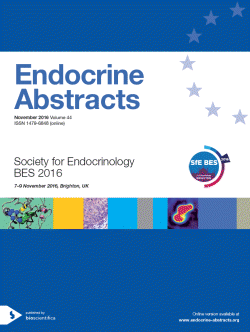
Society for Endocrinology BES 2016
Brighton,
UK
07 Nov 2016 - 09 Nov 2016

Oral Communications
Early Career Oral Communications
ea0044oc1.1 | Early Career Oral Communications | SFEBES2016
Mutations in SGPL1, encoding sphingosine-1-phosphate lyase, cause a novel form of primary adrenal insufficiency with steroid resistant nephrotic syndrome
Prasad Rathi , Maharaj Avinaash , Meimaridou Eirini , VanVeldhoven Paul , Buonocore Federica , Bergada Ignacio , Barbagelata Eliana , Cassinelli Hamilton , Das Urmi , Krone Ruth , Saleem Moin , Hacihamdioglu Bulent , Sari Erkan , Storr Helen , Achermann John , Guasti Leonardo , Braslavsky Debora , Guran Tulay , Ram Nanik , Metherell Lou
ea0044oc1.2 | Early Career Oral Communications | SFEBES2016
11β-HSD1 deficiency modulates brain energy homeostasis during acute systemic inflammation
Verma Manu , Kipari Tiina , Man Tak Yung , Forster Thorsten , Homer Natalie , Seckl Jonathan , Holmes Megan , Chapman Karen
ea0044oc1.3 | Early Career Oral Communications | SFEBES2016
Investigating the interaction between KNDy peptides on gonadotrophin release in humans – novel findings with therapeutic importance
Narayanaswamy Shakunthala , Prague Julia K , Jayasena Channa N , Papadopoulou Deborah A , Mizamtsidi Maria , Shah Amar J , Bassett Paul , Comninos Alexander N , Abbara Ali , Bloom Stephen R , Veldhuis Johannes D , Dhillo Waljit S
ea0044oc1.4 | Early Career Oral Communications | SFEBES2016
The urinary steroid metabolome as a non-invasive tool to stage non-alcoholic fatty liver disease
Moolla Ahmad , Amin Amin , Hughes Bev , Arlt Wiebke , Hassan-Smith Zaki , Armstrong Matt , Newsome Philip , Shah Tahir , Van Gaal Luc , Verrijken An , Francque Sven , Biehl Michael , Tomlinson Jeremy
ea0044oc1.5 | Early Career Oral Communications | SFEBES2016
A missense mutation in the islet-enriched transcription factor MAFA leads to familial insulinomatosis and diabetes
Iacovazzo Donato , Flanagan Sarah E. , Walker Emily , Caswell Richard , Brandle Michael , Johnson Matthew , Wakeling Matthew , Guo Min , Dang Mary N. , Gabrovska Plamena , Niederle Bruno , Christ Emanuel , Jenni Stefan , Sipos Bence , Nieser Maike , Frilling Andrea , Dhatariya Ketan , Chanson Philippe , de Herder Wouter , Konukiewitz Bjorn , Kloppel Gunter , Stein Roland , Ellard Sian , Korbonits Marta
ea0044oc1.6 | Early Career Oral Communications | SFEBES2016
A time controlled β-cell specific mouse model Men1L/L/RIP2-CreER for pancreatic neuroendocrine tumours (NETs)
Vas Nunes Roeland P , Frost Morten , Stevenson Mark , Lines Kate E , Thakker Rajesh V



